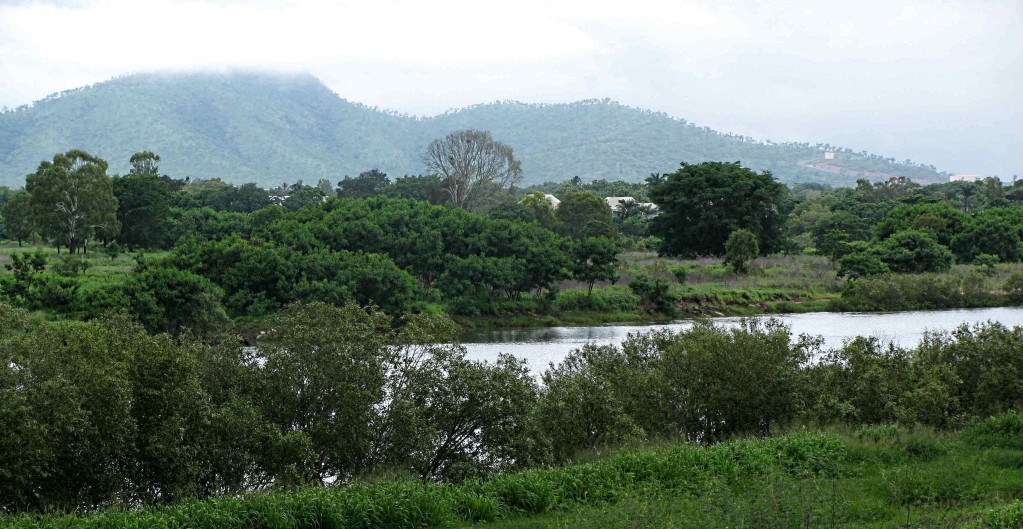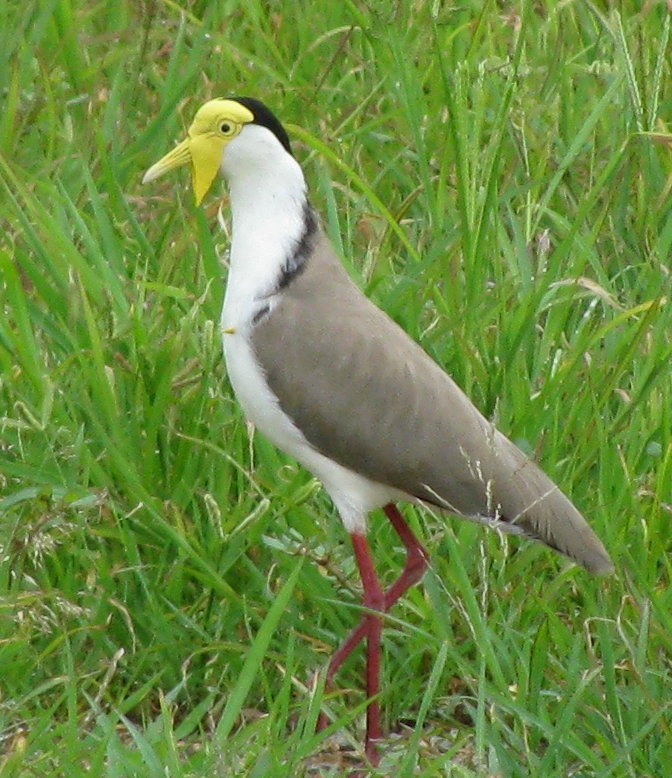
Ross River in Townsville, Queensland (© Magi Nams)
This morning, I ran and walked in greater comfort than two days ago, the humidity level lower, a welcome breeze stealing away perspiration. The Ross River curled big and lazy in early light, its banks lush with shrubs, its sand flats carved by heavy run-off, its waters almost still, their surface lightly flecked by the caress of gentle wind. Two Australian pelicans standing on a sandbar looked like dumpy black and white sentinels carrying broadsword beaks. Upon lifting into the air, they transformed into stately airships that cruised low over the river, their shadows black, sharp-prowed galleons plying the green water.
The Ross River is a constant presence in the city of Townsville, its serpentine course and frequent flooding having dictated the settlement pattern and architectural style of this urban centre first founded in 1864 by John Melton Black and Robert Towns.1 With flooding markedly reduced since the construction of the Ross River Dam, the river environs now offer prime real estate and the extensive Ross River Parkway, a city-managed green space that stretches for a dozen kilometres or more along the waterway and provides paved paths for pedestrians and cyclists. From the access to the park at the end of Richard’s street, we could walk, run, or cycle to JCU and beyond via these paths. Back in Canada, when I investigated Townsville using Google-Earth, the one striking feature of the city to which I was immediately attracted was the river and this parkway.

Masked Lapwing (© Magi Nams)
As I ran and walked, dense cumulus clouds to the north built into atmospheric cisterns promising to tip their contents in later hours. Overhead, a Brahminy kite, superbly elegant in its plumage of chestnut with black wing tips and searing white head and breast, flapped across the river with the regal air of an eagle. On the lawns alongside me, masked lapwings shattered the air with rapid-fire calls. Sulphur-crested cockatoos slumped on power lines above Queen Street as though still weary at 5:45a.m., although they roused themselves to oust a pair of Australian magpies that flew up to join them.
Where the path passed close to back yards of palm-shielded homes, a kookaburra stood amid grasses, shaking a frog imprisoned in its beak. Then it hurled its prey to the ground and gulped down a morsel torn loose from the carcass. Only a few feet away, startling beauty flitted within a low shrub in the form of a male mistletoebird, the tiny avian sprite’s glossy black back contrasting vividly with its neon scarlet throat and under-tail coverts. While the city awakened, life and death adorned its twisting, riverine belly in the deadly stab of a chisel beak and the brilliant hues of a jester.
During the evening, while checking out potential houses to rent, Vilis and I noticed a community garden sandwiched between Robertson Street and Desmond Street Park in southern Railway Estate. This garden was unlike any with which I am familiar, its fenced-in area sprouting ragged clumps of banana plants and what appeared to be sugar cane or a relative of it. Not a single row of northern vegetables was to be seen anywhere.

Townsville Community Garden Showing Banana Plants (© Magi Nams)
Vilis struck up a conversation with the lone gardener we saw, a husky, sweat-beaded fellow wearing a t-shirt proudly proclaiming ‘Papua New Guinea.’ With gentle, good-humoured patience, the gardener, who grew up in the mountains of PNG but is now immersed in the lengthy process of obtaining permanent Australian residency, explained that he grows bananas (of which there are, apparently, more than a thousand varieties), bok choy, and Chinese cabbages.
“How long does it take for bananas to grow?” Vilis asked. “About a year,” was the reply.
“How do you start them growing?” “Usually, you take a little piece of new growth and plant that. You see that little green thing?” He pointed to a pale green shoot emerging from within layers of dead leaf bases on the vertical stalk. ”You take something like that.”
“How do you know when the bananas are ripe?” “They’re ripe when the leaves turn brown.”
“So, after the bananas are harvested, does the stem get cut down?” I inquired. “Yes, but the little shoots will grow.”
“Does that mean that the first year, there’s only one clump of bananas, but then after that, there are more?” Vilis asked. “Yes,” was the response.
“How do you harvest the bananas?” “You make a cut into the stem and it will lean over. Then you can grab the stem with the bananas on it, so when everything comes down, it doesn’t fall on them.”
Upon learning that we’re from Canada, the gardener grinned. “I met one person from Canada. He was really crazy. He was from… Saskatchewan. He was telling me all kinds of things about his personal life. I didn’t want to hear that. I thought maybe all people from Canada are crazy like that.”
Vilis and I laughed and told him that all Canadians are definitely not like that.
The gardener pointed out cassava plants, the roots of which are used to make tapioca. The cassavas had narrow, palmate leaves vaguely similar to those of cannabis and its relatives. The gardener also showed us a tall, leafy vegetable with a name he rolled off his tongue, but which I couldn’t retain. He said it could be cooked like spinach, and then shared a recipe with us for cooking chicken and green onions in diluted coconut milk, and then, after removing the chicken from the liquid, cooking some of the mystery vegetable or spinach in the milky sauce. “It’s good to try something new,” he recommended.
By that time, mosquitoes had appeared, their presence nudging us toward our vehicles. To the south, ranges of sweeping, pointed hills were brushed with evening sun, while to the northwest, Castle Hill reared against the sky, the colour of its blocky, salmon granite echoed in the walls of houses at its feet. In the yards of those homes, palm fronds spilled over enclosing walls or arced high above them in the company of lush trees possessing canopies like vast umbrellas or blossoms like fire.

Reference:
1. Emma Gregg. The Rough Guide to East Coast Australia. 2008. Rough Guides, New York, p. 540.


